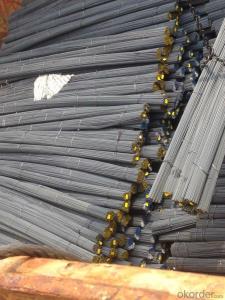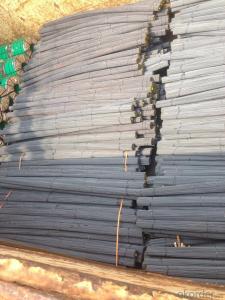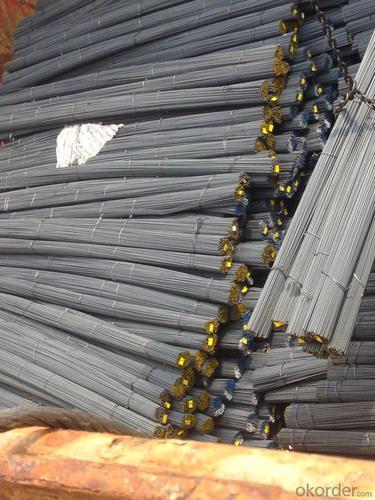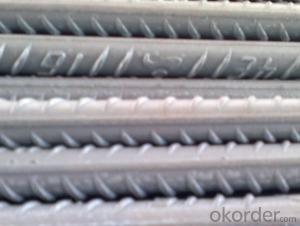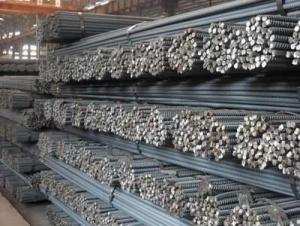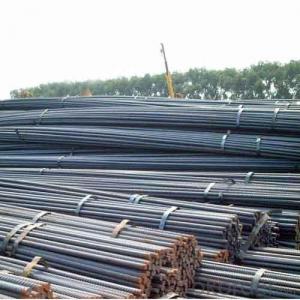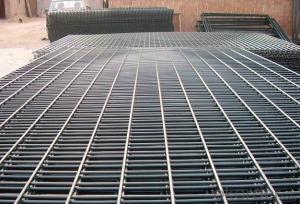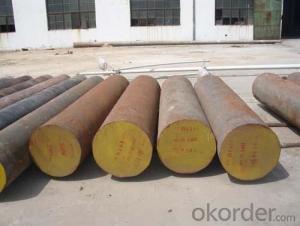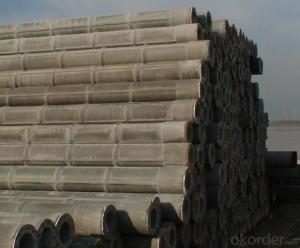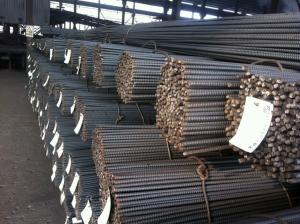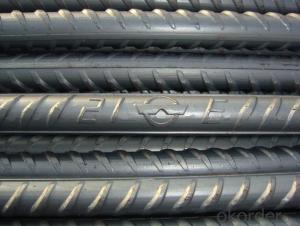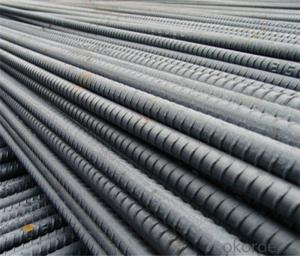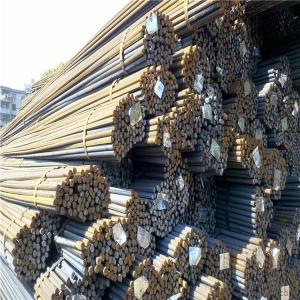Deformed Steel Bar for Construction, High Quality Deformed Bar
- Loading Port:
- Tianjin
- Payment Terms:
- TT OR LC
- Min Order Qty:
- 50 m.t.
- Supply Capability:
- 200000 m.t./month
OKorder Service Pledge
OKorder Financial Service
You Might Also Like
Specification
Product Description of Deformed Steel Bar for Construction, High Quality Deformed Bar:
OKorder is offering Deformed Steel Bar for Construction, High Quality Deformed Bar great prices with worldwide shipping. Our supplier is a world-class manufacturer of steel, with our products utilized the world over. OKorder annually supplies products to European, North American and Asian markets. We provide quotations within 24 hours of receiving an inquiry and guarantee competitive prices.
Product Applications of Deformed Steel Bar for Construction, High Quality Deformed Bar:
Deformed Steel Bar for Construction, High Quality Deformed Bar are ideal for structural applications and are widely used in the construction of buildings and bridges, and the manufacturing, petrochemical, and transportation industries.
Product Advantages of Deformed Steel Bar for Construction, High Quality Deformed Bar:
OKorder's Deformed Steel Bar for Construction, High Quality Deformed Bar are durable, strong, and resist corrosion.
Main Product Features of Deformed Steel Bar for Construction, High Quality Deformed Bar:
· Premium quality
· Prompt delivery & seaworthy packing (30 days after receiving deposit)
· Corrosion resistance
· Can be recycled and reused
· Mill test certification
· Professional Service
· Competitive pricing
Product Specifications of Deformed Steel Bar for Construction, High Quality Deformed Bar:
Standard | GB | HRB400 | |
Diameter | 6mm,8mm,10mm,12mm,14mm,16mm,18mm,20mm, 22mm,25mm,28mm,32mm,36mm,40mm,50mm | ||
Length | 6M, 9M,12M or as required | ||
Place of origin | Hebei, China mainland | ||
Advantages | exact size, regular package, chemical and mechanical properties are stable. | ||
Type | Hot rolled deformed steel bar | ||
Brand name | DRAGON | ||
Chemical Composition: (Please kindly find our chemistry of our material based on HRB500 as below for your information)
Grade | Technical data of the original chemical composition (%) | ||||||
C | Mn | Si | S | P | V | ||
HRB400 | ≤0.25 | ≤1.60 | ≤0.80 | ≤0.045 | ≤0.045 | 0.04-0.12 | |
Physical capability | |||||||
Yield Strength (N/cm²) | Tensile Strength (N/cm²) | Elongation (%) | |||||
≥400 | ≥570 | ≥14 | |||||
Theoretical weight and section area of each diameter as below for your information:
Diameter(mm) | Section area (mm²) | Mass(kg/m) | Weight of 12m bar(kg) |
6 | 28.27 | 0.222 | 2.664 |
8 | 50.27 | 0.395 | 4.74 |
10 | 78.54 | 0.617 | 7.404 |
12 | 113.1 | 0.888 | 10.656 |
14 | 153.9 | 1.21 | 14.52 |
16 | 201.1 | 1.58 | 18.96 |
18 | 254.5 | 2.00 | 24 |
20 | 314.2 | 2.47 | 29.64 |
22 | 380.1 | 2.98 | 35.76 |
25 | 490.9 | 3.85 | 46.2 |
28 | 615.8 | 4.83 | 57.96 |
32 | 804.2 | 6.31 | 75.72 |
36 | 1018 | 7.99 | 98.88 |
40 | 1257 | 9.87 | 118.44 |
50 | 1964 | 15.42 | 185.04 |
Usage and Applications of Deformed Steel Bar for Construction, High Quality Deformed Bar:
Deformed bar is widely used in buildings, bridges, roads and other engineering construction. Big to highways, railways, bridges, culverts, tunnels, public facilities such as flood control, dam, small to housing construction, beam, column, wall and the foundation of the plate, deformed bar is an integral structure material. With the development of world economy and the vigorous development of infrastructure construction, real estate, the demand for deformed bar will be larger and larger..
Packaging & Delivery of Deformed Steel Bar for Construction, High Quality Deformed Bar:
Packaging Detail: products are packed in bundle and then shipped by container or bulk vessel, deformed bar is usually naked strapping delivery, when storing, please pay attention to moisture proof. The performance of rust will produce adverse effect.
Each bundle weight: 2-3MT, or as required
Payment term: TT or L/C
Delivery Detail: within 45 days after received advanced payment or LC.
Label: to be specified by customer, generally, each bundle has 1-2 labels
Trade terms: FOB, CFR, CIF
Images of Deformed Steel Bar for Construction, High Quality Deformed Bar:
I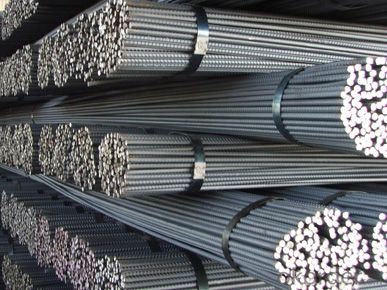
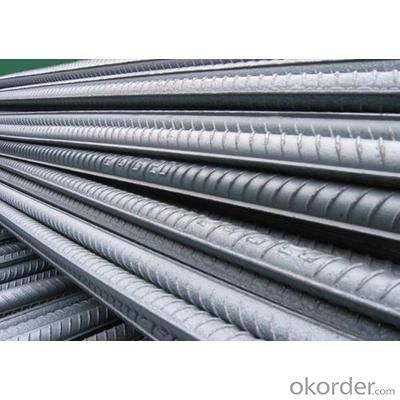
Note:
1. Our products are produced according to national standard (GB), if not, supply according to national standards (GB) or agreement as customer required.
2. Other Grade and Standard Deformed Steel Bar we can supply:
Grade: GR40/GR60, G460B/B500A/B500B/B500C,BST500S
Standard: ASTM, BS, DIN
The Minimum Order Quantity of these products is high, and need to be confirmed.
3. We can not only supply Deformed Steel Bar; if you need anything about building materials, please contact us for further information.
4. Please send us your detail specifications when inquire. We will reply to you as soon as possible. We sincerely hope we can establish a long stable business relationship.
FAQ:
Are you a trading company or manufacturer? | Manufacturer |
What’s the MOQ? | 3 metric ton |
What’s your delivery time? | 15-35 days after downpayment received |
Do you Accept OEM service? | Yes |
what’s your delivery terms? | FOB/CFR/CIF |
What's the Payment Terms? | 30% as deposit,70% before shipment by T/T |
Western Union acceptable for small amount. | |
L/C acceptable for large amount. | |
Scrow ,Paybal,Alipay are also ok | |
Why choose us? | Chose happens because of quality, then price, We can give you both. Additionally, we can also offer professional products inquiry, products knowledge train (for agents), smooth goods delivery, excellent customer solution proposals. |
What's your available port of Shipment? | Main Port, China |
What’s your featured services? | Our service formula: good quality+ good price+ good service=customer's trust
|
Where are your Market? | Covering more than 160 countries in the world |
- Q: What is the weight of a standard steel rebar?
- The weight of a standard steel rebar can vary depending on its size and length.
- Q: Are steel rebars suitable for use in high-temperature applications?
- High-temperature applications are generally not suitable for the use of steel rebars. Despite being a strong and durable material, steel has limitations when exposed to high temperatures. It can undergo a significant reduction in strength and even a loss of structural integrity, leading to potential failures. When subjected to high temperatures, steel goes through a process known as thermal expansion, which can weaken and deform it. This phenomenon is particularly noticeable in rebars, which are commonly used to reinforce concrete structures. The high temperatures cause the rebars to expand, exerting excessive pressure on the surrounding concrete. This pressure can result in cracks and potentially compromise the stability of the structure. Furthermore, prolonged exposure to high temperatures can cause a loss of the steel's mechanical properties, including its tensile strength and load-bearing capacity. As a result, the rebars become less effective in resisting external forces and reinforcing the concrete. For this reason, it is generally recommended to consider alternative materials, such as stainless steel or special alloys, for high-temperature applications. These materials are specifically designed to withstand elevated temperatures without compromising their structural integrity. To ensure safety and structural stability, it is important to consult with experts and engineers who are familiar with high-temperature applications in order to determine the most suitable materials for specific projects.
- Q: What is the difference between steel rebars and FRP rebars?
- Construction projects use steel rebars and FRP rebars as reinforcement materials, but they differ in composition and mechanical properties. Steel rebars, made of carbon steel, are known for their strength and durability, making them a reliable choice for reinforcing concrete structures. On the other hand, FRP rebars are composed of fibers embedded in a polymer matrix, such as glass or carbon. This composite material offers advantages over steel rebars. Firstly, FRP rebars are lighter, making them easier to handle and transport, reducing labor and equipment costs. Secondly, FRP rebars do not corrode, unlike steel rebars. Steel rebars are prone to corrosion when exposed to moisture and chemicals, weakening the structure over time. FRP rebars, however, are resistant to rust and corrosion, making them ideal for environments with high humidity, saltwater, or chemical exposure. Additionally, FRP rebars have a high resistance to electromagnetic fields, making them suitable for sensitive areas like hospitals, power plants, or telecommunication facilities, where minimizing electromagnetic interference is crucial. However, FRP rebars have lower tensile strength compared to steel rebars, making them less suitable for heavy-load-bearing structures. Moreover, FRP rebars initially cost more than steel rebars, but their long-term durability and reduced maintenance requirements can offset this expense. In conclusion, the differences between steel rebars and FRP rebars lie in their composition, mechanical properties, and performance in various environmental conditions. Steel rebars offer high tensile strength but are susceptible to corrosion, while FRP rebars are lighter, non-corrosive, and have a high resistance to electromagnetic fields. The choice between the two depends on project requirements, load-bearing needs, and environmental factors.
- Q: How do steel rebars perform in extreme temperature conditions?
- Steel rebars perform well in extreme temperature conditions. Steel has a high melting point and thermal conductivity, allowing it to maintain its structural integrity even at elevated temperatures. Additionally, steel has a low coefficient of thermal expansion, reducing the risk of cracking or warping due to thermal stress. However, it is important to consider the specific grade and composition of the steel rebar, as certain alloys may exhibit different behavior in extreme temperatures.
- Q: Can steel rebars be used in combination with other reinforcement materials?
- Yes, steel rebars can be used in combination with other reinforcement materials such as fibers, wire mesh, or carbon fiber sheets to enhance the overall strength and durability of concrete structures. This combination of reinforcement materials provides a more effective solution for reinforcing concrete and can meet specific project requirements.
- Q: What are the different types of couplers used for connecting steel rebars?
- There are several types of couplers used for connecting steel rebars, including mechanical couplers, lap splices, and grouted splices. Mechanical couplers are typically threaded or tapered and provide a mechanical connection between the rebars. Lap splices involve overlapping the rebars and securing them with tie wires or welding. Grouted splices involve placing the rebars in a sleeve or coupling filled with grout to create a bonded connection.
- Q: How are steel rebars used in bridge construction?
- Steel rebars are used in bridge construction to reinforce the concrete structures, providing strength and durability. They are placed within the concrete to withstand tension forces and prevent cracking or collapsing of the bridge.
- Q: How are steel rebars handled and installed in congested reinforcement areas?
- In congested reinforcement areas, steel rebars are typically handled and installed using specialized tools and techniques. Construction workers often use lifting devices or cranes to move the rebars into position, taking care to avoid damaging surrounding structures or other reinforcement elements. In tight spaces, rebars may be manually maneuvered and adjusted using hooks or other tools, ensuring proper alignment and spacing as per design specifications. Additionally, the rebars may be tied together with wire or welded to form a stable reinforcement structure. The process requires skilled workers who are experienced in working with rebars in congested areas to ensure accurate and safe installation.
- Q: What are the different methods of joining steel rebars in a structure?
- The different methods of joining steel rebars in a structure include lap splicing, mechanical splicing, and welded splicing.
- Q: What are the different methods of protecting steel rebars against corrosion?
- There are multiple methods available for safeguarding steel rebars from corrosion, which can be broadly categorized into passive and active protection. Passive protection methods involve using barrier coatings or inhibitors to prevent corrosive agents from reaching the surface of the steel rebars. One commonly used technique is applying epoxy coatings, which create a physical barrier between the rebar and its surrounding environment. These coatings can be administered through spraying, brushing, or immersion, and offer excellent corrosion protection. Another passive protection method is utilizing zinc-based coatings like galvanization or zinc-rich paints. These coatings provide sacrificial protection, where the zinc layer corrodes first, thereby shielding the steel rebar from corrosive elements. Galvanization, a widely adopted technique, involves immersing the rebar in molten zinc to form a protective layer. In addition to barrier coatings, inhibitors can also be employed to protect steel rebars. Inhibitors work by reducing the corrosive activity of the surrounding environment. Common inhibitors include calcium nitrite, which forms a protective layer on the rebar's surface, and organic compounds such as amines and phosphates, which passivate the steel and decrease corrosion rates. Active protection methods involve using impressed current cathodic protection (ICCP) or galvanic anodes. ICCP entails applying a direct electrical current to the steel rebar, counteracting the corrosive forces. This technique necessitates the installation of anodes and a power supply system. On the other hand, galvanic anodes are sacrificial metals like aluminum or magnesium that are connected to the steel rebar. The anode corrodes instead of the rebar, offering protection. It is important to consider various factors, including the environment, exposure conditions, and project requirements, when selecting a protection method. Consulting corrosion experts or engineers is often recommended to determine the most suitable method for safeguarding steel rebars from corrosion in a specific situation.
Send your message to us
Deformed Steel Bar for Construction, High Quality Deformed Bar
- Loading Port:
- Tianjin
- Payment Terms:
- TT OR LC
- Min Order Qty:
- 50 m.t.
- Supply Capability:
- 200000 m.t./month
OKorder Service Pledge
OKorder Financial Service
Similar products
Hot products
Hot Searches
Related keywords
